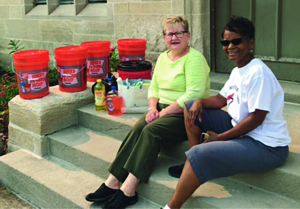By Jill Lorie Hurst
Photo by Bernie LaFramboise
THEY POPPED UP QUIETLY, SHORTLY AFTER THE 2016 PRESIDENTIAL ELECTION: THE SIGNS. A new group of signs that appeared as the campaign signs came down. Poster board with printed words that reminded us that we are a community,not only locally, but globally.
The first sign I noticed was the tri-colored, “No matter where you’re from, we’re glad you’re our neighbor”. A simple, powerful statement written in English, Arabic and Spanish. Once I noticed the first, I started to look for them – and there they were, all around town. That sign and others that expressed beliefs that support our freedoms and human rights for all.
I wanted one for my lawn, but couldn’t figure out how to get one without stealing it off a neighbor’s lawn. 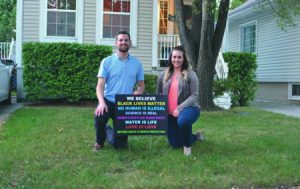 Sarah Lynn Fox liked the signs she was seeing, too. She and her husband, Brian Stawowy, noticed them as they walked their dogs around the neighborhood. Sarah said, “It made me feel so great to see all the signs…proud to live in Ferndale.”
Sarah Lynn Fox liked the signs she was seeing, too. She and her husband, Brian Stawowy, noticed them as they walked their dogs around the neighborhood. Sarah said, “It made me feel so great to see all the signs…proud to live in Ferndale.”
She tried to get a “Hate Has No Home Here” sign, but it was back-ordered. Not one to sit and wait around for someone else to solve her problem, Sarah went online and found a web site (signsonthecheap.com) that allows you to create and print your own signs. She came up with a similar design and decided to print in bulk. She would make 100 signs and offer them to others, for free. “I wanted to spread a little bit of hope around the community.” A co-worker told her she was crazy: No one would want the signs. And what would Brian say? Sarah posted on the Facebook Ferndale Forum, and the response was overwhelming.
And although Sarah offered the signs for free, the community was all too happy to help finance the project. One person sent $200 dollars to help. Another person who contributed money doesn’t even live in Ferndale anymore, but liked the project enough to support it. By the time the signs came in, Sarah had a spreadsheet with 300 names on it, people waiting for signs.
The night she set out to deliver the first batch, Brian was with her all the way. It turned out to be quite an adventure. He smiles, remembering that first delivery outing. “It was fun. We got to learn a lot about the 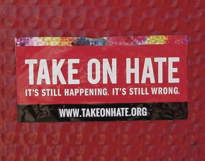 town.” They both mention “admiring their neighbors’ houses, the front yard gardens”. Brian said the best part was “us working together and meeting our neighbors face-to-face.” They loved the chance to get to know more about their adopted home town. People were friendly, inviting them in and sharing their Ferndale knowledge with them.
town.” They both mention “admiring their neighbors’ houses, the front yard gardens”. Brian said the best part was “us working together and meeting our neighbors face-to-face.” They loved the chance to get to know more about their adopted home town. People were friendly, inviting them in and sharing their Ferndale knowledge with them.
I was sure Sarah and Brian were native Ferndalians, but they both grew up north of the Detroit area, moving to the area for work (him) and grad school (her). They met downtown after a Tigers game. In 2013, when they decided to settle down together, they found their way to Ferndale because of easy access to Detroit and a dog-friendly community. Sign distribution is just one of the changes in their life since January. They’ve attended immigration marches and city council meetings. Sarah: “We didn’t know our congressional district or who our state representatives were until this year.” She added “If the election results had been different, our lives would be different.”
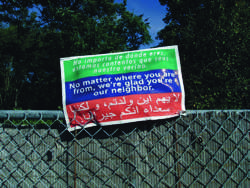 Along with the signs, Fox and Stawowy are circulating petitions to support “Voters, Not Politicians,” a ballot proposal to end gerrymandering in Michigan. It’s an important, non-partisan issue. “You have to start some-where,” says Fox. “We can no longer make excuses to not get involved.”
Along with the signs, Fox and Stawowy are circulating petitions to support “Voters, Not Politicians,” a ballot proposal to end gerrymandering in Michigan. It’s an important, non-partisan issue. “You have to start some-where,” says Fox. “We can no longer make excuses to not get involved.”
Sarah Lynn Fox and Brian Stawowy are living breathing “signs of hope” for our future. As I walked past their high-ceilinged home after our interview, I read their sign:
We Believe Black Lives Matter
No Human Is Illegal
Science Is Real
Women’s Rights Are Human Rights
Water Is Life • Love Is Love
Mother Earth Is Worth Protecting
Like a light in the window. Signs of hope in Ferndale.


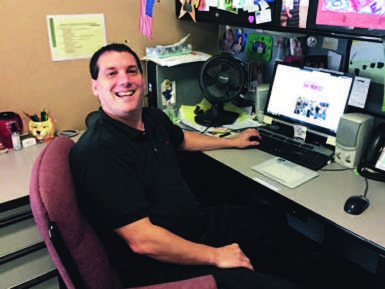
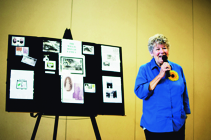
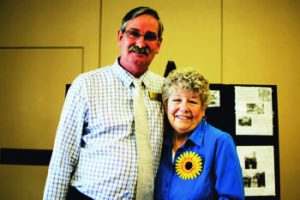 political group.” The visits are merely to provide information to attendees. Politicians and candidates do well to court senior voters. According to
political group.” The visits are merely to provide information to attendees. Politicians and candidates do well to court senior voters. According to 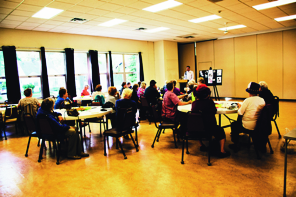 and active communities.” Davis, who retired from running her own business as a real estate appraiser, considers Ferndale as a “senior-friendly” city. “Ferndale is a very walk-able community,” she said. “Also, we love the ‘businesses on Nine’, especially Western Market.” Davis says. She adds that Ferndale’s Metro Detroit location means there are plenty of opportunities for visiting cultural venues and volunteering.
and active communities.” Davis, who retired from running her own business as a real estate appraiser, considers Ferndale as a “senior-friendly” city. “Ferndale is a very walk-able community,” she said. “Also, we love the ‘businesses on Nine’, especially Western Market.” Davis says. She adds that Ferndale’s Metro Detroit location means there are plenty of opportunities for visiting cultural venues and volunteering.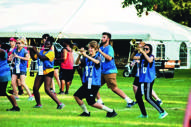

 least two of the 20 or more contests that MCBA holds each year. A band must attain scores at MCBA contests placing it among the 12 highest scoring bands in its flight competition. Judging categories are weighted between musical, visual and overall general effect.
least two of the 20 or more contests that MCBA holds each year. A band must attain scores at MCBA contests placing it among the 12 highest scoring bands in its flight competition. Judging categories are weighted between musical, visual and overall general effect. more about the whole rather than just them-selves.” Langley went on to say, “This activity is the determining factor of success in many kids’ lives.”
more about the whole rather than just them-selves.” Langley went on to say, “This activity is the determining factor of success in many kids’ lives.”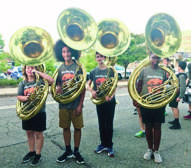 large subcommittee of FAB run by a handful of dedicated parents,” Langley said. “Without them, we would not be able to function at the level we do. They are wizards of finance.
large subcommittee of FAB run by a handful of dedicated parents,” Langley said. “Without them, we would not be able to function at the level we do. They are wizards of finance.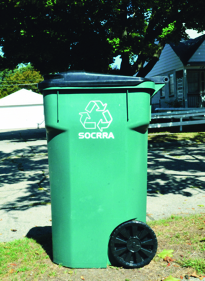
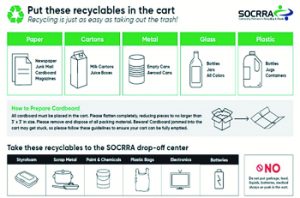 only metal that can go in the carts are cans and empty aerosol cans,” Farris says. “These, along with Styrofoam and plastic bags can be brought to the SOCRRA drop off center for recycling.”
only metal that can go in the carts are cans and empty aerosol cans,” Farris says. “These, along with Styrofoam and plastic bags can be brought to the SOCRRA drop off center for recycling.”
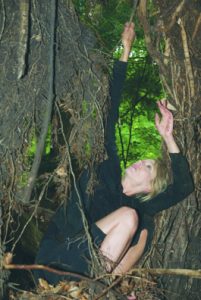 so therapeutic, are you a movement therapist?’ As I continued to dance and perform and teach, I found I was incorporating what I was learning from life/art workshops into classrooms and performances. There is an artful lens to view any and every situation, whether it’s in education, social action, or personal development. When we engage our creativity hand in hand with body expression – there is an opportunity to shift and move in new ways physically and metaphorically.”
so therapeutic, are you a movement therapist?’ As I continued to dance and perform and teach, I found I was incorporating what I was learning from life/art workshops into classrooms and performances. There is an artful lens to view any and every situation, whether it’s in education, social action, or personal development. When we engage our creativity hand in hand with body expression – there is an opportunity to shift and move in new ways physically and metaphorically.”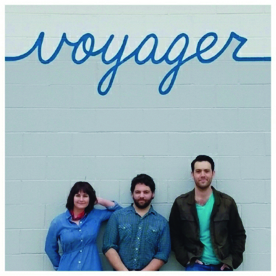
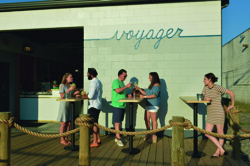 ile and stylish gold trim. The color palette and vaguely Scandinavian-inspired design gives off a mid-century modern vibe, bolstered by the vintage school chairs that double as seating. The 1,400-square-foot space seats 40, with 12 seats at the long bar and 28 in the dining room, which is split from the bar by a low divider sporting individual drink shelves, or “niches,” instead of a rail. Because of the restaurant’s petite size, the single glass-paneled garage door provides ample natural light. It is rolled up in warmer months to add a few more seats on the indoor/outdoor patio.
ile and stylish gold trim. The color palette and vaguely Scandinavian-inspired design gives off a mid-century modern vibe, bolstered by the vintage school chairs that double as seating. The 1,400-square-foot space seats 40, with 12 seats at the long bar and 28 in the dining room, which is split from the bar by a low divider sporting individual drink shelves, or “niches,” instead of a rail. Because of the restaurant’s petite size, the single glass-paneled garage door provides ample natural light. It is rolled up in warmer months to add a few more seats on the indoor/outdoor patio.
